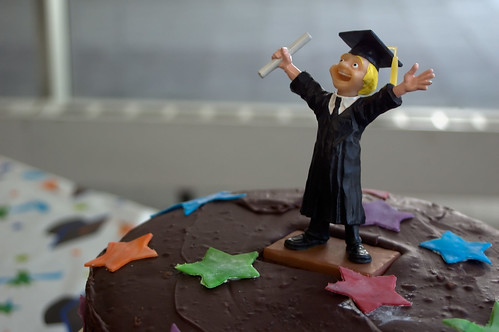
**I told this story live at Ignite NewsFoo in December 2011. You can watch it here.**
Right now, if you don’t mind, I’d like to tell you a story about my mother.
Eleven months ago, I was returning home. I’d spent six months studying abroad in a very pleasant beachside town in Spain. I was well-tanned and full of doner kebabs. My town was just a week away from celebrating its annual bullfights-and-sangria-and-fireworks festival, and the Spanish national team was in the semifinals of the European Championships. I very much did not want to leave.
But it is out of this — just before the crescendo — that I found myself leaving. I boarded a plane in the heart of the country and landed nine hours later in Atlanta, where the heat index was topping three figures. Baggage claim at customs was slightly less packed than a Mumbai rail station. The customs agents were surly, as their baggage sorter had just broken, which left thousands of bags piled up at the gates, looking surprisingly like the Agro Crag on Nickelodeon’s “Guts.” Atlanta, I should note, is really not the kind of place that America should be using to greet our foreign guests.
But soon enough, I found myself leaving Atlanta and heading home to Washington, D.C., where temperatures were cooling into the high 90s, where the humidity just sort of wicks away from your body until you’re left stewing like a game hen in a crock pot. I was flying into Dulles Airport; my family was meeting me there.
It is here that I must remind you that this is a story about my mother.
She had decided earlier in the day that she would make a sign with which to greet me at baggage claim. At the time, this seemed like a good idea 1..
She went to my younger sister, Ellen, and my brother, Sam. Both speak Spanish. She asked them to do a bit of light translation for her 2.. “I want the sign to say, ‘Welcome home, my big boy,'” she said. Ellen and Sam told her that they could help her with that. My mother, so overwhelmed by the return of her eldest, most prodigious son, neglected to realize that her two youngest children have a sense of humor more twisted than a licorice rope.
It is into this that I arrived at Dulles Airport. Over my shoulder, I had two bags. One was a guitar case that bulged in the middle and looked unusually like a Kirstie Alley “before” photo in a Weight Watchers commercial. The other was an LL Bean backpack that was only being held together with scotch tape and safety pins. In my rush to pack, I had attempted to load nearly 4,000 lbs. of souvenirs into four bags. My two checked bags had tipped the scales at 48 and 46.5 lbs., respectively, just under the 50 lb. airline-mandated limit. The remaining 3,905.5 lbs. had been stuffed into my carry-ons and maneuvered into overhead bins for my flights.
I mention this because, ordinarily, I am a fairly spry individual. And on this day, it would have been nice to have felt youthful legs beneath me. Instead, I was essentially anchored to the ground by my luggage.
This was an unfortunate break. Leaving the terminal, I saw the unmistakable figure of four Oshinskys. Behind them, a small crowd had seemed to gather around my mother. I mistook this for coincidence; unbeknownst to me 3., it was not.
The crowd was waiting to find out for whom this woman was holding her sign.
Minutes earlier, an Aeromexico flight from Mexico City had landed at Dulles Airport. One by one, the crowd had passed through baggage claim and seen my mother — a white, Jewish, non-Spanish speaker — proudly clutching a white sign with thick black lettering.
On its front, it read: “Hola, Dan, mí puta grande.”
Which, even if you’d spent your entire vacation inside a tequila slammer at Señor Frogs, you could accurately translate as “Hello, Dan, my big bitch.”
And so the entire adult male population of Mexico City — or something close to it — had collected their luggage and then moved toward my mother, waiting for her puta grande to appear.
It is into this that I appeared, some 3,905.5 lbs. of luggage dragging me down the hallway. I remember looking down the hall and seeing my mother, bouncing up and down, holding her sign. I remember getting close enough to read the words. I remember processing the words in my head, six months of Spanish still very fresh in my mind. I remember taking off, my legs breaking free from the ground, looking not unlike the Beast breaking his chains in “The Sandlot.” I remember my mother moving at top speed, setting what must’ve been a world record in the 60-meter dash, the sign still waving above her head. I remember her catching up to me at about baggage claim #7. I remember looking back; Ellen and Sam were laughing. The entire adult male population of Mexico City was laughing.
I remember looking up, into my mother’s eyes. She was crying.
“Do you like the sign?” she asked.
I smiled back. She wouldn’t know why until later. We’d wait until we were onto the highway, the TrailBlazer cruising along at 70 miles per hour, before we’d teach her her first four words in Spanish. We knew she wouldn’t throw Ellen and Sam out the window at 70 miles per hour.
I looked back up at my mother. Her eyes were fogging up. I smiled back and told her the only thing she wanted to hear.
“Yes, yes I do,” I said.
❡❡❡
1.) N.B.: The phrase at “at the time” can not and will not ever be followed by a clause of a positive nature. No one has ever used the phrase to introduce a pleasant memory. I have tried to find a way to do such a thing; I have failed. It is, at this point, my linguistic holy grail. >back to article
2.My mother, who does not fully understand the Internet, had never before heard of Google Translation. >back to article
3. “Unbeknownst to me” is the second most ominous phrase in the English language, only behind “at the time.” >back to article
That photo at top, from left to right: Sam, me, and my mother.






